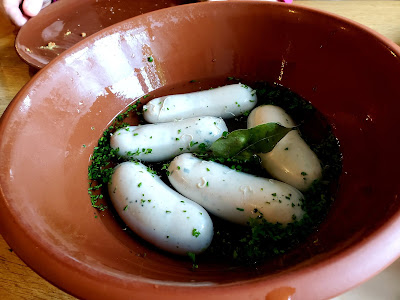During the night the ship has cruised down the Mosel and then took a right at Koblenz to get back onto the Rhine River.
When we awoke, we were docked in Boppard. There is a town out there; and again, with the morning fog, we just can't see it.
Boppard itself is a designated Fremdenverkehrsort (state-recognized tourism resort), known for its wine growing. Word of its famed wines started with the Romans in 643 and today, it is actually the biggest wine-growing center in the Middle Rhine.
Today we chose to go on an optional tour to the Marksburg Castle, one of the most beautiful structures along the Rhine River and the country's only 13th-century fortress unchanged by war or reconstruction. We will see what it was actually like to live here in medieval times.
A coach bus drops us off at the bottom of a narrow trail that leads to the castle.
Our castle guide is waiting for us with the key to open the doors.
We walk up some more. The Marksburg Castle is nearly all original construction. We head to the inner gate, originally tall enough for knights on horseback to gallop through, it was made smaller and therefore safer from enemies on horseback.
And above the gate is the "murder hole"--handy for pouring hot pitch on invaders.
Once inside, we navigate our way over rough stone
These are from the noble families who have owned the castle since 1283.
A peak into a room off the hallway
Back outside we see the cannons from around 1640.
This smaller cannon is from 1500. Cannon balls were rough to let the explosive force leak out.
Walking along the outer wall, we see about 160 plants from the Middle Ages--used for cooking, medicine, and witchcraft. Supposedly there is hemlock planted here but I didn't see it.
We enter the Hall of the Knights. This was the dining hall. The long table is an unattached plank. After each course, servants could replace it with another pre-set plank.
Through a door behind the dining table is the outhouse, made of wood, hanging over the side of the castle.
When not in use, it's door was locked to prevent any invaders from entering this weak point in the castle's defenses.The chapel is still painted in Gothic style with the castle's namesake, St. Mark, and his lion.
The next room held an exhibit of two thousand years of armor.
The last room we saw was the horse stable, which now shows the tools used for punishment.
Many times the accused was simply taken into a torture dungeon to see all these tools, and guilty or not, confessions spilled out.
The picture on the wall show various medieval capital punishments.
We left the castle and headed to the castle's restaurant for a German Breakfast.
First a soft pretzel...And then 3 different kinds of German sausages.
They were good, but I liked the middle one the best.
After the castle tour, we had time for a short stroll through Boppard.
The historic streets are lined with half-timbered buildings.The Church of St. Severus is a beautiful example of late Romanesque architecture. 13th-century Severuskirche was built on the site of Roman military baths and a 6th century Christian church.
Then it was time to head back to the ship as we would set sail this afternoon through the most beautiful part of the Rhine River where we will see castles on both sides of the river.
We pass small villages
We sat on the outside deck with our friends, Joyce and Neal
It is not long before we come to the first castles--the Liebenstein Castle and Sterrenberg Castle. These neighboring castles are called the "Hostile Brothers" castles. Evidently the brothers didn't get along.
Ever since Roman times, the Rhine has been one of the world's busiest shipping rivers. We see barge after barge passing us as we cruise.
Schonburg Castle sits above the medieval town of Oberwesel. The town goes back as far as 400 BC. The castle is now a posh hotel.
Pfalz Castle and Gurenfels Castle collected tolls from passing ships. Pfalz Castle sits on an island in the Rhine and stretched chains across the river to block the boats that didn't pay the toll.
Stahleck Castle, above the town, was home to one of the seven electors who chose the Holy Roman Emperor.
Another pretty town along the river--Lorch. There are no bridges along this stretch of the Rhine so a ferry is how the locals get across.
Again, the hillsides are filled with vineyards. The Rhine Valley produces some great white wines, particularly the whites known as Rieslings. The ancient Romans planted the first vines here.
We sail on to Speyer where we find out there has to be changes to our itinerary. To continue reading, scroll down and click on "Newer Post".






























































No comments:
Post a Comment